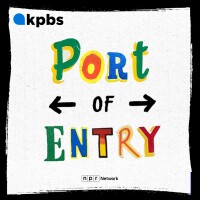Port of Entry

These are cross-border stories that connect us. Border people often inhabit this in-between place. From KPBS and California Humanities, “Port of Entry” tells personal stories from this place — stories of love, hope, struggle, and survival from border crossers, fronterizxs, and other people whose lives are shaped around the wall. Rooted in San Diego and Tijuana, we are a transborder podcast for transborder people. We live life on la linea.
Have you checked out our podcast in Spanish? If so, Take our survey.
¿Hás escuchado nuestro podcast en Español? Participa en nuestra encuesta.
Ways To Subscribe
-
This episode first aired in September 2019. Los Angeles is a giant when it comes to making movies. Here in San Diego and Tijuana, we’re stuck under the huge shadow of L.A. It’s hard to compete with Hollywood. But think about it: the border has good bones for eventually becoming a film mecca. It’s one, big, super diverse place that offers access to two really different backdrops. Plus, shooting a film in Mexico is a lot cheaper. And there’s not as much red tape when it comes to permits. Unfortunately, though, a lot of large-scale production companies only think about the border when they’re thinking about movies or TV shows about narcos and drugs. Lots of filmmakers only see the Mexico-U.S. border as a backdrop for stories about drug cartel violence. It’s become such a trope that “narco-fatigue” is a term now. Folks are exhausted by news and pop culture focused on the drug trade in Mexico. Yeah, it’s a huge issue here, but it’s just way over done. Locally, though, some filmmakers like Omar Lopex are using the border to their advantage, making movies that have nothing to do with narcos. And that trend is starting to pick up some steam thanks to efforts by local film groups that are working hard to boost filmmaking in our binational region. Today, a story about filming across borders. Only here will you find filmmakers in San Diego and Tijuana using the border as a valuable resource instead of a janky prop.
-
This episode first aired in April 2019. According to the federal government, about 90,000 people cross legally through the San Ysidro Port of Entry every single day. Among those daily crossers are the hundreds of students who live in Tijuana, but get their education in San Diego. The international trek to school is long and annoying. But it can also be traumatic. Today, a story about students who cross the international border for their education, and a teacher who’s trying to better understand them. Only here can you find students navigating one of the busiest border crossing in the world just to get to school.
-
We want to tell you about an exciting new season of KPBS Explore podcast, "Rad Scientist." Recent events involving the killing of unarmed Black people have brought discussions about racism to the forefront, including at scientific institutions. This season of KPBS Explore podcast "Rad Scientist" is centered on Black scientists, from graduate students to faculty to those who have left the ivory towers. They study bug microbiomes, autism, neural prosthetics and more. But they will also discuss how racism has impacted their scientific journey. First episode drops Sept. 2. Subscribe here: https://www.kpbs.org/podcasts/rad-scientist/
-
Meet a San Diego artist who dresses up as a “cleaning lady” to force a conversation about immigrant women. This episode first aired in June 2019. About the Show: “Only Here” is about the unexplored subcultures, creativity and struggles at the U.S.-Mexico border. The KPBS podcast tells personal stories from people whose lives are shaped by the tension reverberating around the wall. This is a show for border babies, urban explorers or those who wonder what happens when two cultures are both separated and intertwined. Who's behind the show: Host Alan Lilienthal, producer Kinsee Morlan and sound designer Emily Jankowski Follow Us: https://www.facebook.com/onlyherepodcast/ https://www.instagram.com/onlyherepodcast/ Support Us: https://www.kpbs.org/donate Give us Feedback: 619-452-0228 podcasts@kpbs.org
-
- This episode first aired in October of 2019. - Lowriders are big in Japan. These days, the customized, slow and low to the ground cars and bikes can be found almost anywhere. Lowriding is a culture created by Chicanos and exported all over the world. But at the border, the lowrider scene is a lifeline. For lots of people here, lowriders are much more than just a hobby. The culture that’s coalesced around lowriders on both sides of the border has offered some people here salvation. It’s given new meaning and purpose to peoples’ lives — from deportees in Tijuana to military veterans struggling with PTSD in San Diego. In this episode of "Only Here," a KPBS podcast about art, culture and life at the Western Hemisphere’s busiest border crossing, we bring you a story about lowriders as life rafts.
-
In this episode: A story about trash and dirt flowing from one side of the U.S.-Mexico border to the other, and two guys’ plan to stop it. This episode first aired in December of 2019. About the Show: “Only Here” is about the unexplored subcultures, creativity and struggles at the U.S.-Mexico border. The KPBS podcast tells personal stories from people whose lives are shaped by the tension reverberating around the wall. This is a show for border babies, urban explorers or those who wonder what happens when two cultures are both separated and intertwined. Follow Us: https://www.facebook.com/onlyherepodcast/ https://www.instagram.com/onlyherepodcast/ Support Us: https://www.kpbs.org/donate Give us Feedback: 619-452-0228 podcasts@kpbs.org
-
For years, Beto Soto had two secrets. And these weren’t small secrets. These were really big secrets. The kind that define who you are. Soto is openly gay now, but he didn’t come out of the closet until a few years ago. He's also been living without citizenship papers in the United States since his family brought him here when he was 6. He kept his undocumented status quiet until recently, too. In this episode from our archive, we talk to Soto about being gay and undocumented, and the photographic series he made about the experience. This episode first aired on March 20, 2019.
-
The perception that the U.S.-Mexico border’s been effectively sealed shut because of the pandemic is wrong. Lots of people are still crossing. Actually, the biggest, most dramatic change in who can’t cross right now; you’re not going to find those folks at the ports of entry. Instead, you have to look inside Tijuana’s migrant shelters, and at the refugees who can’t seek asylum in the U.S. right now and are instead stuck in border towns. So that's what we do today. We talk to a migrant stuck at the border, and a doctor trying to help. About the Show: “Only Here” is about the unexplored subcultures, creativity and struggles at the U.S.-Mexico border. The KPBS podcast tells personal stories from people whose lives are shaped by the tension reverberating around the wall. This is a show for border babies, urban explorers or those who wonder what happens when two cultures are both separated and intertwined. Who's behind the show: Host Alan Lilienthal, producer Kinsee Morlan and sound designer Emily Jankowski Follow Us: https://www.facebook.com/onlyherepodcast/ https://www.instagram.com/onlyherepodcast/ Support Us: https://www.kpbs.org/donate Give us Feedback: 619-452-0228 podcasts@kpbs.org Just a few of the nonprofits working with migrants in Tijuana: https://www.refugeehealthalliance.org/ https://alotrolado.org/ https://haitianbridge.org/ https://www.instagram.com/temploembajadoresdejesus/ https://www.facebook.com/EspacioMigranteOrg/
-
Everyone has songs they treasure — songs that evoke vivid memories and color different periods of our lives. Sometimes, music ends up shaping who we become. For Paola Villaseñor, better known as the influential border artist Panca, music from both sides of the border has been a lifelong companion whenever she’s painting. Sometimes, lyrics from songs or traces of the flow and melody of music can be found in her final works. Today, we’ve got a story about one of our border region’s most well-known artists, told through the lens of music. About the Show: “Only Here” is about the unexplored subcultures, creativity and struggles at the U.S.-Mexico border. The KPBS podcast tells personal stories from people whose lives are shaped by the tension reverberating around the wall. This is a show for border babies, urban explorers or those who wonder what happens when two cultures are both separated and intertwined. Follow Us: https://www.facebook.com/onlyherepodcast/ https://www.instagram.com/onlyherepodcast/ Support Us: https://www.kpbs.org/donate Give us Feedback: 619-452-0228 podcasts@kpbs.org
-
We caught up with Jenn Budd at Las Americas mall a few months before the pandemic hit. Jenn has become well known in the border activism world. Her criticisms of U.S. immigration policies and Customs and Border Protection are harsh, and very personal. Because Jenn; she used to be a Border Patrol agent herself. Today, a story about a big perspective shift at the border. It’s also a story about how some people have to hit rock bottom before they change. About the Show: “Only Here” is about the unexplored subcultures, creativity and struggles at the U.S.-Mexico border. The KPBS podcast tells personal stories from people whose lives are shaped by the tension reverberating around the wall. This is a show for border babies, urban explorers or those who wonder what happens when two cultures are both separated and intertwined. Follow Us: https://www.facebook.com/onlyherepodcast/ https://www.instagram.com/onlyherepodcast/ Support Us: https://www.kpbs.org/donate Give us Feedback: 619-452-0228 podcasts@kpbs.org
Alan Lilienthal is a musician and the co-host of “Port of Entry,” a KPBS podcast about cross-border culture and the people who shape it. His life’s mission is to melt borders and celebrate our shared humanity through art.
Natalie Gonzalez is the co-host of ‘’Port of Entry” — a KPBS podcast. The podcast covers stories about cross-border people whose lives have been shaped by Tijuana and San Diego. Natalie is also a theater actress from Tijuana Hace Teatro. She studied at Universidad Iberoamericana in Tijuana where she graduated from Communications and Media School.

This project was made possible in part with support from California Humanities, a non-profit partner of the National Endowment for the Humanities. Visit calhum.org.












